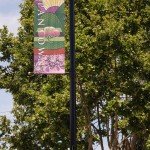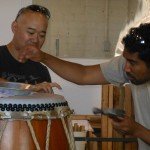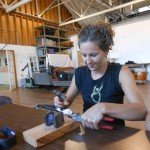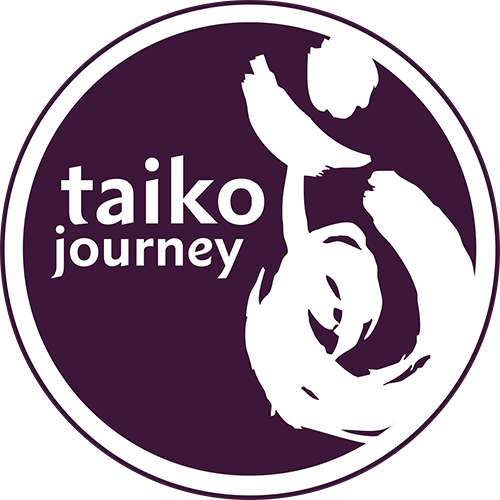I’ve just discovered that my travelling fellowship is taking me on a 16664 mile journey…I have only got a little longer until I go home, but at least I get to spend them in my favourite place: with San Jose Taiko, Japan Town, California.
San Jose Taiko – I can’t seem to put it into words….
 PJ & Roy Hirabayashi. These two people have given so much to people’s lives that I can’t hope to summarise their significance in the taiko world in a sentence, but I can say that it has been nothing but an honour to spend so much time with them and to spend most waking hours discussing or doing something taiko-related. And I think this really hits the nail on the head for me as to why I see that taiko can be such an instrumental ‘thing’ within a community – it doesn’t start and stop with playing the drums. San Jose Taiko embodies what I would call the ‘essence of taiko’ for me (if I weren’t too aware of this sounding like such pretentious statement) bec
PJ & Roy Hirabayashi. These two people have given so much to people’s lives that I can’t hope to summarise their significance in the taiko world in a sentence, but I can say that it has been nothing but an honour to spend so much time with them and to spend most waking hours discussing or doing something taiko-related. And I think this really hits the nail on the head for me as to why I see that taiko can be such an instrumental ‘thing’ within a community – it doesn’t start and stop with playing the drums. San Jose Taiko embodies what I would call the ‘essence of taiko’ for me (if I weren’t too aware of this sounding like such pretentious statement) bec
ause of what they do and the way it’s done. Allow me to try to explain how my activities over the last week have made me say such a thing.I have watched San Jose Taiko rehearse for their fall show, ‘Rhythm Spirit 2012: Taiko & Technology’- most of my time is spent in awe of the end product, which would take a project in itself to describe the synchronicity and energy that projects out of the studio, but it’s also the way they run rehearsals that’s inspiring. The group started out in the 1970’s as a collective and even today it’s run with the assumption that everyone has something to offer, with different people running sections/overseeing/giving feedback/writing/performing the songs, and it all works like a highly functioning family unit. It’s an art in itself, and so much more inspiring for me than seeing one person mastermind something and produce it artistically single-handedly, which is probably more impressive, much harder work and higher-risk.
Eating is believing…
I’ve eaten lunch in the San Jose Taiko office – staff members take it in turn to cook/provide lunch for the work team each day. This not only reduces the time everyone spends preparing lunch each day for themselves, makes sure no-one forgets lunch and therefore suffers low-energy throughout the afternoon, (and makes people learn how to make GREAT food!), it ensures that everyone has time to down tools and talk about things and occasionally say hello to visiting taiko people. Some ‘big’ companies that inspire me at this time – Patagonia, Innocent, Howies – all have similar work/social time ethics and it can’t be coincidence. It seems like a small point, but I know these small things make a huge difference to people and therefore a company’s ability to function highly and have a great reputation.
A place to call home…
I have hung out in Japan Town, where San Jose Taiko’s heart has always been – as you walk around there are placards telling the story of the town’s history, and right there is an early picture of the group, as from the very beginning they have been focused on positive social action in the community, and have become as much a part of the town as the bricks that built it. I’ve attended a party for a local artists’ mural project (where the hosts just happen to be a family who are taking taiko sessions with PJ as a family) and where everyone knows PJ & Roy, and of course one of the local mural artists is a San Jose Taiko performing and staff member.
Isn’t it good? when everyone works together…
 Today I attended a San Jose Taiko “workday”, one of 6 such annual occasions where all of San Jose Taiko get together to work on studio and drum maintenance. I spent a good 2 hours clearing Bougainvillea from the street, one of a team of 12 who worked hard in the sun until the job was done, and then moved onto polishing chappa and straightening taiko tacks for recycling in an delightfully industrious atmosphere, and of course, we ate great food. I wasn’t the only visitor who was happy to get my hands dirty and get involved – some of the Stanford Taiko (last seen on Mount Shasta and previously starring in the UK Taiko Festival in June) were around and wanted to help – help with vacuum cleaning, cleaning windows, re-skinning taiko, washing water filters, sewing costume – when was the last time one of your friends came over to help with your housework? It’s rare, but because of who they are, the fact that everyone there is committed to the group and feels a part of this
Today I attended a San Jose Taiko “workday”, one of 6 such annual occasions where all of San Jose Taiko get together to work on studio and drum maintenance. I spent a good 2 hours clearing Bougainvillea from the street, one of a team of 12 who worked hard in the sun until the job was done, and then moved onto polishing chappa and straightening taiko tacks for recycling in an delightfully industrious atmosphere, and of course, we ate great food. I wasn’t the only visitor who was happy to get my hands dirty and get involved – some of the Stanford Taiko (last seen on Mount Shasta and previously starring in the UK Taiko Festival in June) were around and wanted to help – help with vacuum cleaning, cleaning windows, re-skinning taiko, washing water filters, sewing costume – when was the last time one of your friends came over to help with your housework? It’s rare, but because of who they are, the fact that everyone there is committed to the group and feels a part of this  community, got such a great attitude, people want to help. This particular couple of days got me thinking about the integrity of the group – San Jose Taiko’s Director, PJ Hirabayashi created a very popular taiko song and Obon-style dance that’s working its way around the world in taiko groups…called Ei Ja Nai Ka, translated as Isn’t It Good…it’s about physical hard labour and the joy of working together (and so much more!). This last vcouple of days never felt like work, and I’d do it again tomorrow.
community, got such a great attitude, people want to help. This particular couple of days got me thinking about the integrity of the group – San Jose Taiko’s Director, PJ Hirabayashi created a very popular taiko song and Obon-style dance that’s working its way around the world in taiko groups…called Ei Ja Nai Ka, translated as Isn’t It Good…it’s about physical hard labour and the joy of working together (and so much more!). This last vcouple of days never felt like work, and I’d do it again tomorrow.
Can’t put it into words…
I’ve watched a public workshop be given, talked about taiko when eating, walking, driving, shopping, and of course, I’ve also been taking taiko lessons, but it’s not really the point…everything that I find myself doing here is taiko. When I think or say that the art of taiko is about community, it doesn’t have to mean (as is so often interpreted) that it is not high-end art; it means that the art and the community have a fulfilling relationship. There is the local community, the taiko community, the group community, the family communities…nothing is separated or excluded but everything is respected. I am aware that I may sound like a die-hard San Jose Taiko fan, and actually I like their performances and they happen to inspire me as a performer, but what I mean to convey is this: the past few days have gone to show me how complex the ‘work’ of a taiko company or group is and how magnificent it can be when done with such an open heart.
And they’re not alone; this is my point. Taiko groups everywhere have connections that go way past pitching up at practice and learning a song, and it’s this very fact that makes it such a special thing. Even if you take taiko as a purely technical instrument or art to learn (which for me, is not how I chose to see it), you can’t apply normal parameters to it. It’s such a small network of people who will be able to help you replace a head of a taiko for the first time. Few people understand how to play Taiko Tetris in the back of a van like a taiko-player. As someone recently remarked; how many rock gigs do you play when after the show, audience members are outside with great food for you, and are ready to help you out with your gear? At this stage, I don’t really care that I’m not even making a point. I feel privileged just to be able to say that I’ve experienced it.

Leave a Reply